HRM Report: Practices, Benefits, and Impact on Organizational Success
VerifiedAdded on 2023/01/17
|17
|5371
|81
Report
AI Summary
This report provides a comprehensive analysis of Human Resource Management (HRM) practices, focusing on recruitment, selection, employee benefits, and their impact on organizational performance. The report examines the purposes and functions of HRM, including staffing needs and benefit programs, and explores different recruitment and selection approaches, highlighting their strengths and weaknesses. It investigates the benefits provided to both employers and employees through various HRM practices, such as training and development, work-life balance, and career development, using examples from Chocolate Presence and Microsoft. Furthermore, the report analyzes how HRM practices can increase organizational profits and productivity, emphasizing the importance of employee relationships and legislation in influencing HRM decision-making. The report concludes with an overview of the application of HRM practices within organizations.
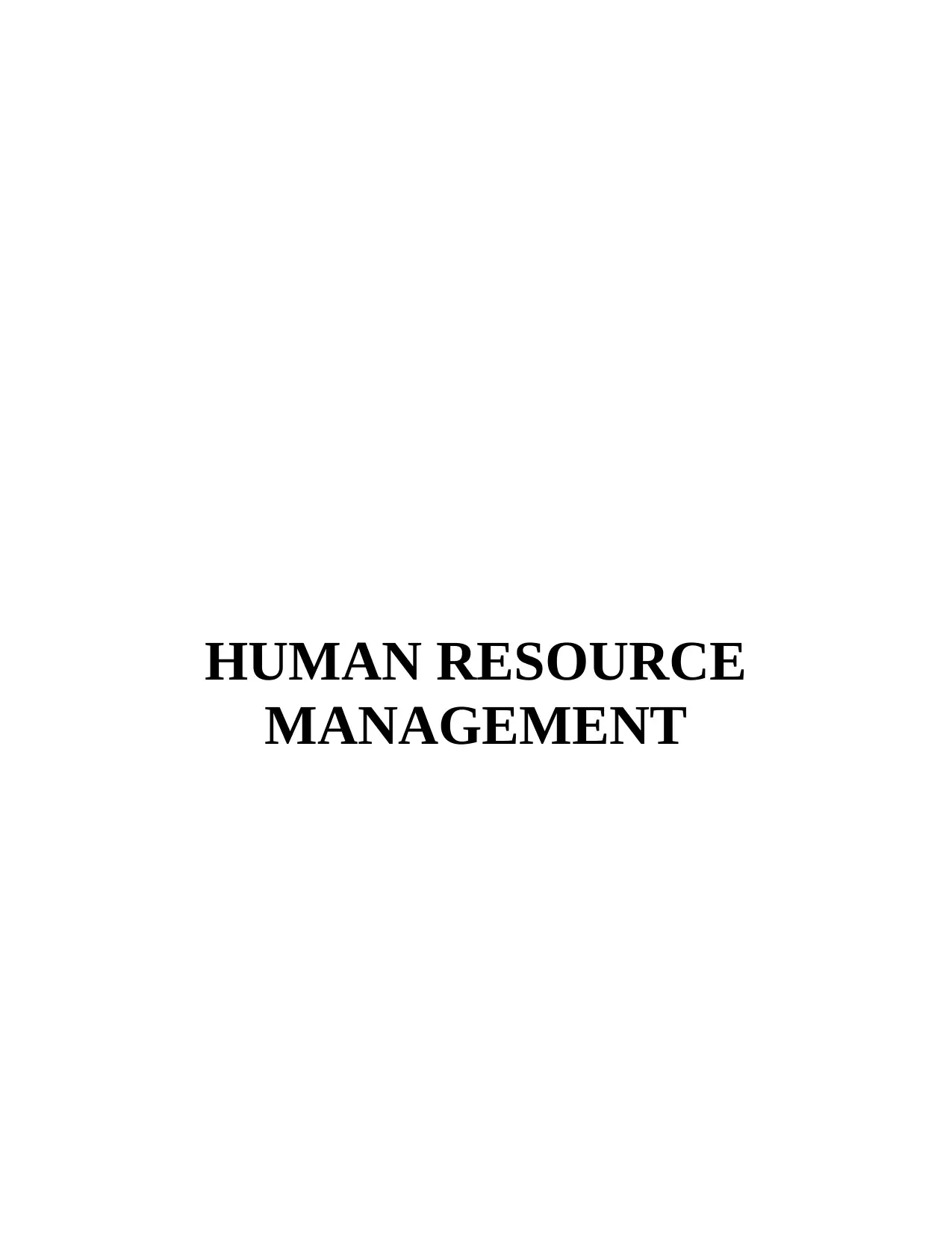
HUMAN RESOURCE
MANAGEMENT
MANAGEMENT
Paraphrase This Document
Need a fresh take? Get an instant paraphrase of this document with our AI Paraphraser
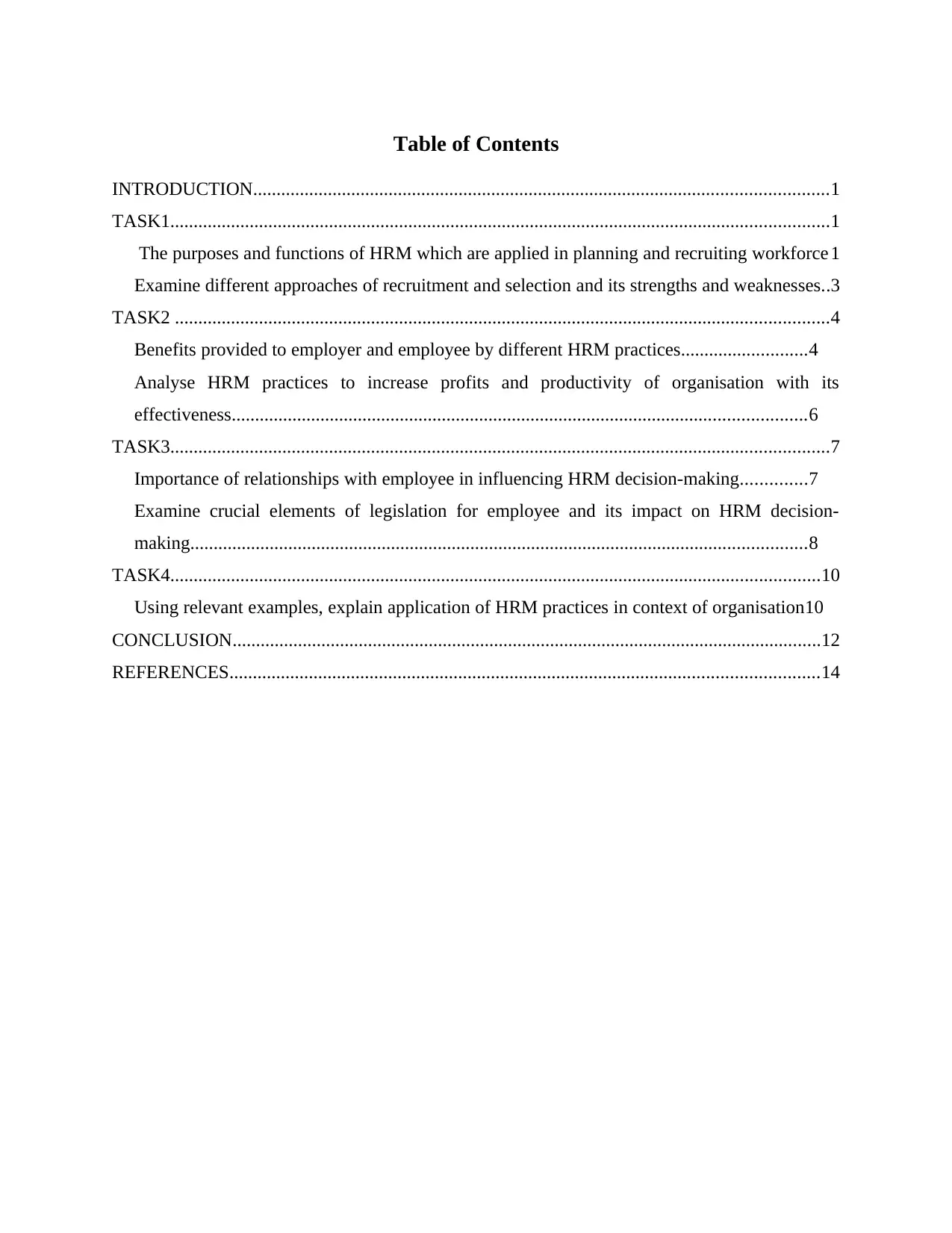
Table of Contents
INTRODUCTION...........................................................................................................................1
TASK1.............................................................................................................................................1
The purposes and functions of HRM which are applied in planning and recruiting workforce 1
Examine different approaches of recruitment and selection and its strengths and weaknesses..3
TASK2 ............................................................................................................................................4
Benefits provided to employer and employee by different HRM practices...........................4
Analyse HRM practices to increase profits and productivity of organisation with its
effectiveness...........................................................................................................................6
TASK3.............................................................................................................................................7
Importance of relationships with employee in influencing HRM decision-making..............7
Examine crucial elements of legislation for employee and its impact on HRM decision-
making....................................................................................................................................8
TASK4...........................................................................................................................................10
Using relevant examples, explain application of HRM practices in context of organisation10
CONCLUSION..............................................................................................................................12
REFERENCES..............................................................................................................................14
INTRODUCTION...........................................................................................................................1
TASK1.............................................................................................................................................1
The purposes and functions of HRM which are applied in planning and recruiting workforce 1
Examine different approaches of recruitment and selection and its strengths and weaknesses..3
TASK2 ............................................................................................................................................4
Benefits provided to employer and employee by different HRM practices...........................4
Analyse HRM practices to increase profits and productivity of organisation with its
effectiveness...........................................................................................................................6
TASK3.............................................................................................................................................7
Importance of relationships with employee in influencing HRM decision-making..............7
Examine crucial elements of legislation for employee and its impact on HRM decision-
making....................................................................................................................................8
TASK4...........................................................................................................................................10
Using relevant examples, explain application of HRM practices in context of organisation10
CONCLUSION..............................................................................................................................12
REFERENCES..............................................................................................................................14
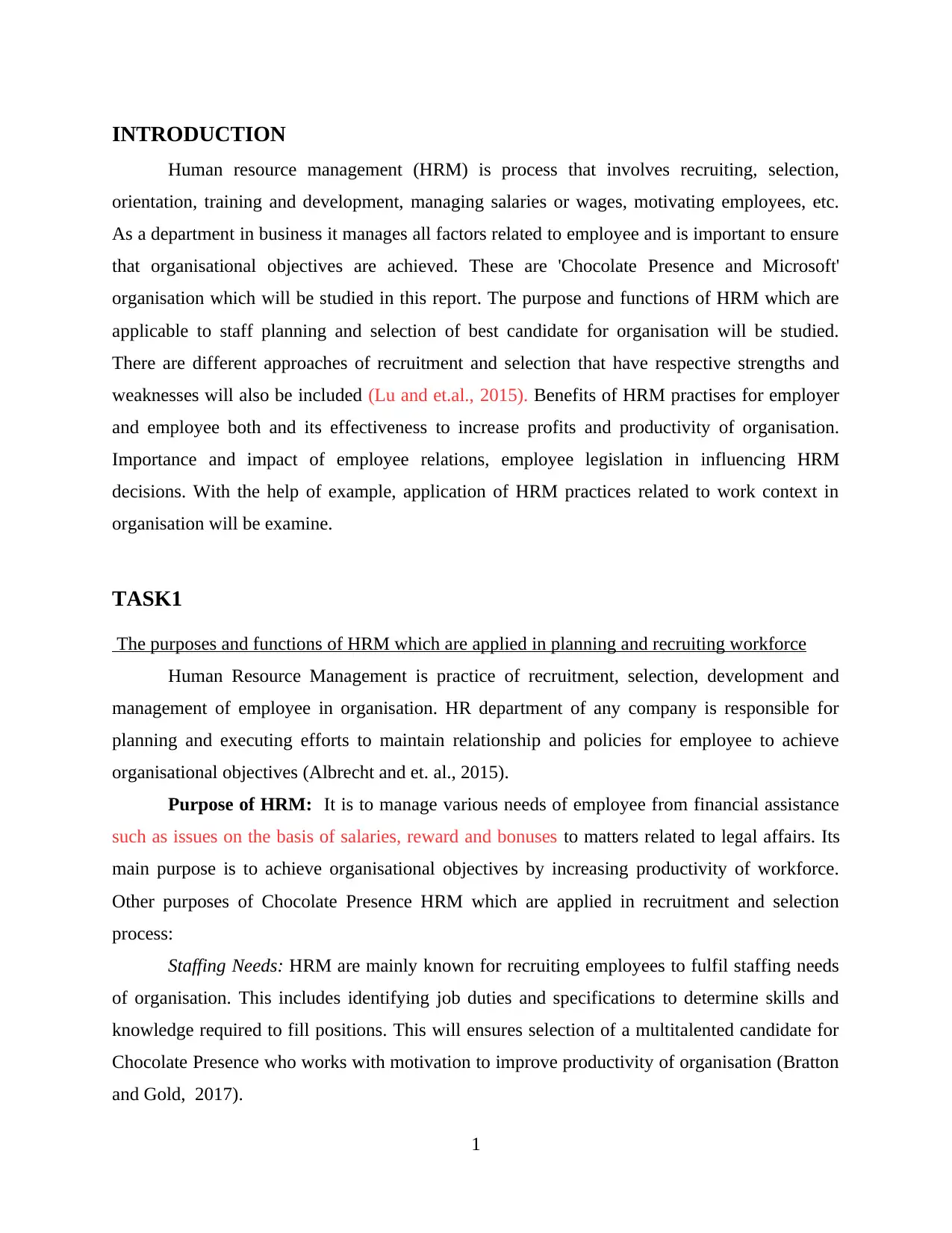
INTRODUCTION
Human resource management (HRM) is process that involves recruiting, selection,
orientation, training and development, managing salaries or wages, motivating employees, etc.
As a department in business it manages all factors related to employee and is important to ensure
that organisational objectives are achieved. These are 'Chocolate Presence and Microsoft'
organisation which will be studied in this report. The purpose and functions of HRM which are
applicable to staff planning and selection of best candidate for organisation will be studied.
There are different approaches of recruitment and selection that have respective strengths and
weaknesses will also be included (Lu and et.al., 2015). Benefits of HRM practises for employer
and employee both and its effectiveness to increase profits and productivity of organisation.
Importance and impact of employee relations, employee legislation in influencing HRM
decisions. With the help of example, application of HRM practices related to work context in
organisation will be examine.
TASK1
The purposes and functions of HRM which are applied in planning and recruiting workforce
Human Resource Management is practice of recruitment, selection, development and
management of employee in organisation. HR department of any company is responsible for
planning and executing efforts to maintain relationship and policies for employee to achieve
organisational objectives (Albrecht and et. al., 2015).
Purpose of HRM: It is to manage various needs of employee from financial assistance
such as issues on the basis of salaries, reward and bonuses to matters related to legal affairs. Its
main purpose is to achieve organisational objectives by increasing productivity of workforce.
Other purposes of Chocolate Presence HRM which are applied in recruitment and selection
process:
Staffing Needs: HRM are mainly known for recruiting employees to fulfil staffing needs
of organisation. This includes identifying job duties and specifications to determine skills and
knowledge required to fill positions. This will ensures selection of a multitalented candidate for
Chocolate Presence who works with motivation to improve productivity of organisation (Bratton
and Gold, 2017).
1
Human resource management (HRM) is process that involves recruiting, selection,
orientation, training and development, managing salaries or wages, motivating employees, etc.
As a department in business it manages all factors related to employee and is important to ensure
that organisational objectives are achieved. These are 'Chocolate Presence and Microsoft'
organisation which will be studied in this report. The purpose and functions of HRM which are
applicable to staff planning and selection of best candidate for organisation will be studied.
There are different approaches of recruitment and selection that have respective strengths and
weaknesses will also be included (Lu and et.al., 2015). Benefits of HRM practises for employer
and employee both and its effectiveness to increase profits and productivity of organisation.
Importance and impact of employee relations, employee legislation in influencing HRM
decisions. With the help of example, application of HRM practices related to work context in
organisation will be examine.
TASK1
The purposes and functions of HRM which are applied in planning and recruiting workforce
Human Resource Management is practice of recruitment, selection, development and
management of employee in organisation. HR department of any company is responsible for
planning and executing efforts to maintain relationship and policies for employee to achieve
organisational objectives (Albrecht and et. al., 2015).
Purpose of HRM: It is to manage various needs of employee from financial assistance
such as issues on the basis of salaries, reward and bonuses to matters related to legal affairs. Its
main purpose is to achieve organisational objectives by increasing productivity of workforce.
Other purposes of Chocolate Presence HRM which are applied in recruitment and selection
process:
Staffing Needs: HRM are mainly known for recruiting employees to fulfil staffing needs
of organisation. This includes identifying job duties and specifications to determine skills and
knowledge required to fill positions. This will ensures selection of a multitalented candidate for
Chocolate Presence who works with motivation to improve productivity of organisation (Bratton
and Gold, 2017).
1
⊘ This is a preview!⊘
Do you want full access?
Subscribe today to unlock all pages.

Trusted by 1+ million students worldwide
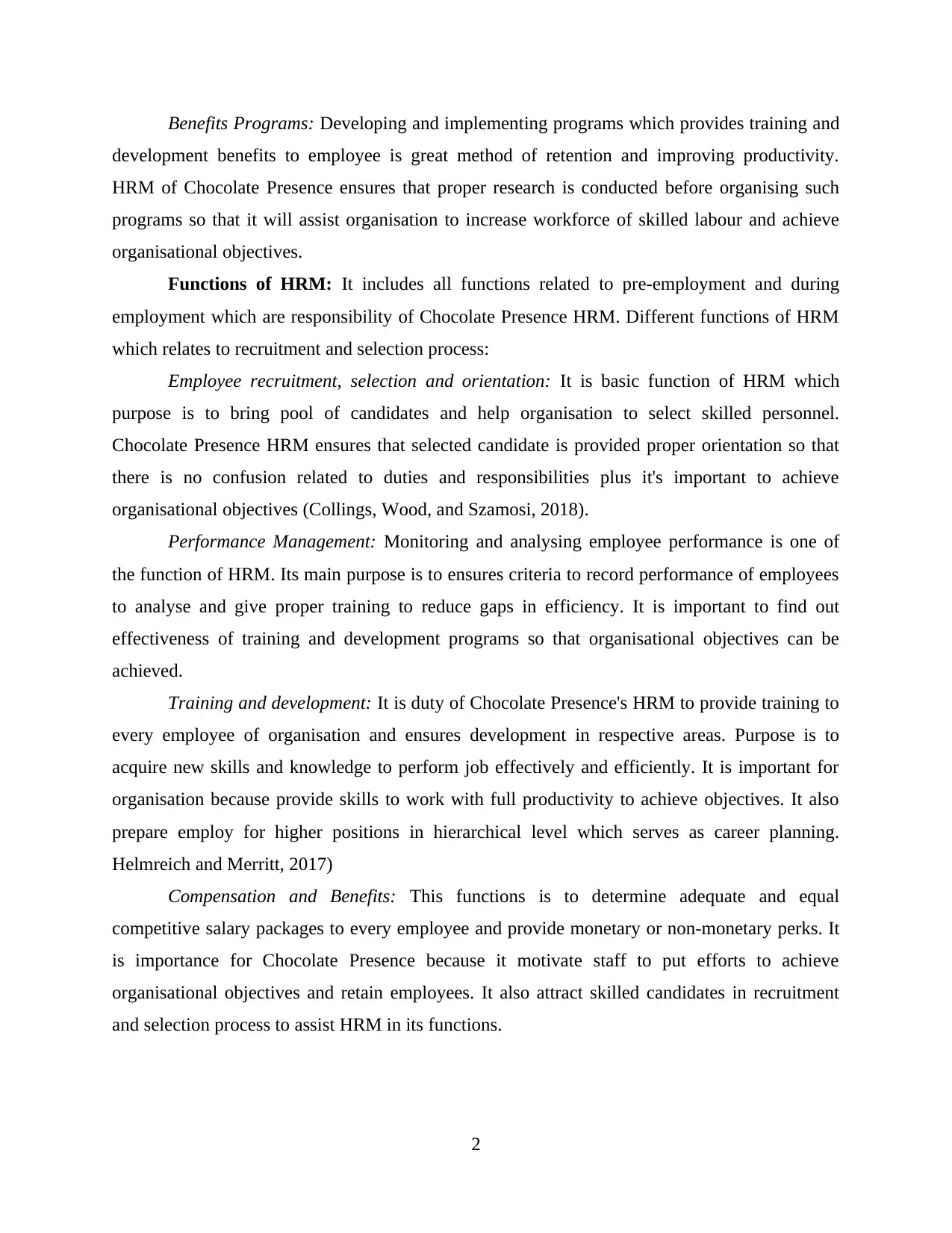
Benefits Programs: Developing and implementing programs which provides training and
development benefits to employee is great method of retention and improving productivity.
HRM of Chocolate Presence ensures that proper research is conducted before organising such
programs so that it will assist organisation to increase workforce of skilled labour and achieve
organisational objectives.
Functions of HRM: It includes all functions related to pre-employment and during
employment which are responsibility of Chocolate Presence HRM. Different functions of HRM
which relates to recruitment and selection process:
Employee recruitment, selection and orientation: It is basic function of HRM which
purpose is to bring pool of candidates and help organisation to select skilled personnel.
Chocolate Presence HRM ensures that selected candidate is provided proper orientation so that
there is no confusion related to duties and responsibilities plus it's important to achieve
organisational objectives (Collings, Wood, and Szamosi, 2018).
Performance Management: Monitoring and analysing employee performance is one of
the function of HRM. Its main purpose is to ensures criteria to record performance of employees
to analyse and give proper training to reduce gaps in efficiency. It is important to find out
effectiveness of training and development programs so that organisational objectives can be
achieved.
Training and development: It is duty of Chocolate Presence's HRM to provide training to
every employee of organisation and ensures development in respective areas. Purpose is to
acquire new skills and knowledge to perform job effectively and efficiently. It is important for
organisation because provide skills to work with full productivity to achieve objectives. It also
prepare employ for higher positions in hierarchical level which serves as career planning.
Helmreich and Merritt, 2017)
Compensation and Benefits: This functions is to determine adequate and equal
competitive salary packages to every employee and provide monetary or non-monetary perks. It
is importance for Chocolate Presence because it motivate staff to put efforts to achieve
organisational objectives and retain employees. It also attract skilled candidates in recruitment
and selection process to assist HRM in its functions.
2
development benefits to employee is great method of retention and improving productivity.
HRM of Chocolate Presence ensures that proper research is conducted before organising such
programs so that it will assist organisation to increase workforce of skilled labour and achieve
organisational objectives.
Functions of HRM: It includes all functions related to pre-employment and during
employment which are responsibility of Chocolate Presence HRM. Different functions of HRM
which relates to recruitment and selection process:
Employee recruitment, selection and orientation: It is basic function of HRM which
purpose is to bring pool of candidates and help organisation to select skilled personnel.
Chocolate Presence HRM ensures that selected candidate is provided proper orientation so that
there is no confusion related to duties and responsibilities plus it's important to achieve
organisational objectives (Collings, Wood, and Szamosi, 2018).
Performance Management: Monitoring and analysing employee performance is one of
the function of HRM. Its main purpose is to ensures criteria to record performance of employees
to analyse and give proper training to reduce gaps in efficiency. It is important to find out
effectiveness of training and development programs so that organisational objectives can be
achieved.
Training and development: It is duty of Chocolate Presence's HRM to provide training to
every employee of organisation and ensures development in respective areas. Purpose is to
acquire new skills and knowledge to perform job effectively and efficiently. It is important for
organisation because provide skills to work with full productivity to achieve objectives. It also
prepare employ for higher positions in hierarchical level which serves as career planning.
Helmreich and Merritt, 2017)
Compensation and Benefits: This functions is to determine adequate and equal
competitive salary packages to every employee and provide monetary or non-monetary perks. It
is importance for Chocolate Presence because it motivate staff to put efforts to achieve
organisational objectives and retain employees. It also attract skilled candidates in recruitment
and selection process to assist HRM in its functions.
2
Paraphrase This Document
Need a fresh take? Get an instant paraphrase of this document with our AI Paraphraser
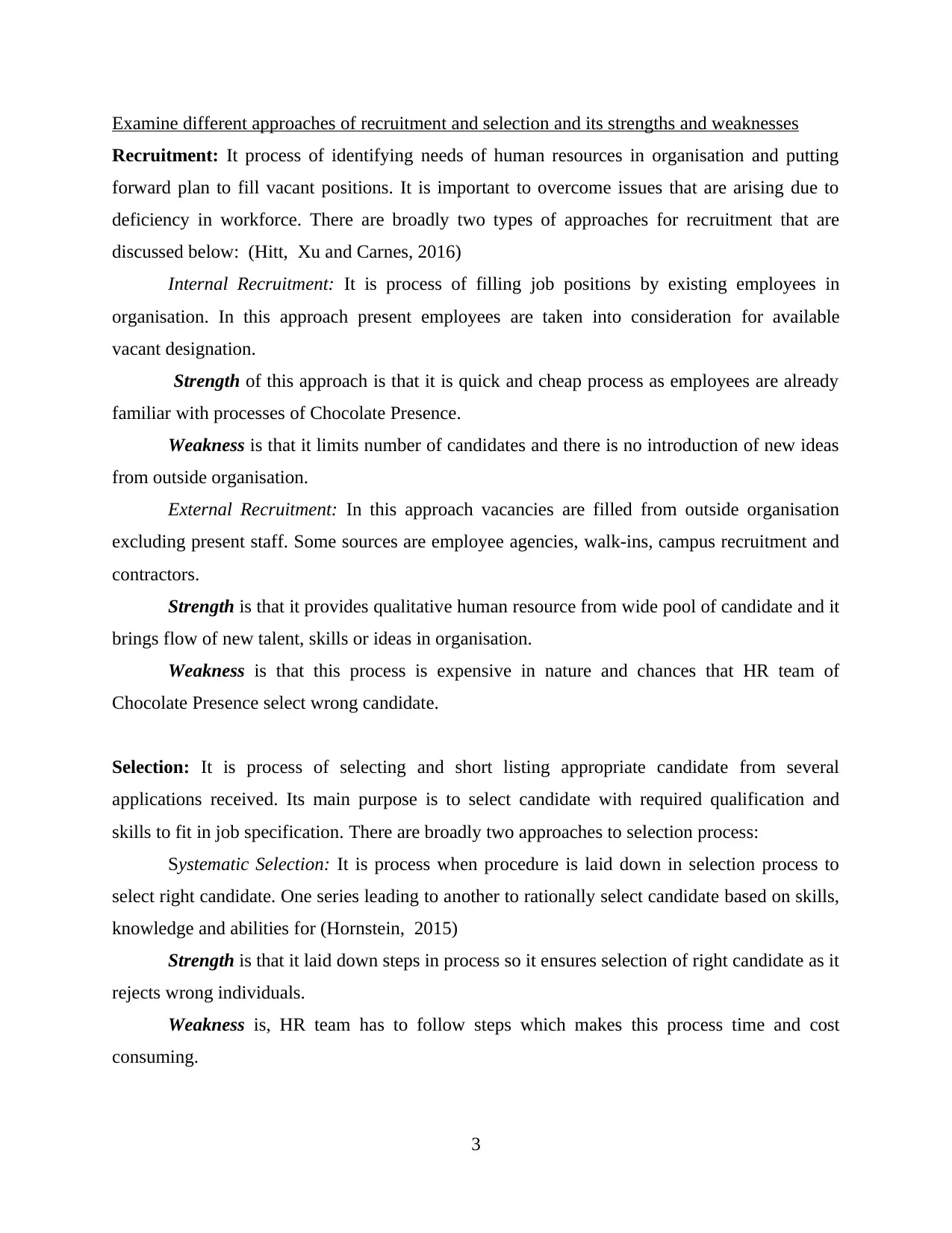
Examine different approaches of recruitment and selection and its strengths and weaknesses
Recruitment: It process of identifying needs of human resources in organisation and putting
forward plan to fill vacant positions. It is important to overcome issues that are arising due to
deficiency in workforce. There are broadly two types of approaches for recruitment that are
discussed below: (Hitt, Xu and Carnes, 2016)
Internal Recruitment: It is process of filling job positions by existing employees in
organisation. In this approach present employees are taken into consideration for available
vacant designation.
Strength of this approach is that it is quick and cheap process as employees are already
familiar with processes of Chocolate Presence.
Weakness is that it limits number of candidates and there is no introduction of new ideas
from outside organisation.
External Recruitment: In this approach vacancies are filled from outside organisation
excluding present staff. Some sources are employee agencies, walk-ins, campus recruitment and
contractors.
Strength is that it provides qualitative human resource from wide pool of candidate and it
brings flow of new talent, skills or ideas in organisation.
Weakness is that this process is expensive in nature and chances that HR team of
Chocolate Presence select wrong candidate.
Selection: It is process of selecting and short listing appropriate candidate from several
applications received. Its main purpose is to select candidate with required qualification and
skills to fit in job specification. There are broadly two approaches to selection process:
Systematic Selection: It is process when procedure is laid down in selection process to
select right candidate. One series leading to another to rationally select candidate based on skills,
knowledge and abilities for (Hornstein, 2015)
Strength is that it laid down steps in process so it ensures selection of right candidate as it
rejects wrong individuals.
Weakness is, HR team has to follow steps which makes this process time and cost
consuming.
3
Recruitment: It process of identifying needs of human resources in organisation and putting
forward plan to fill vacant positions. It is important to overcome issues that are arising due to
deficiency in workforce. There are broadly two types of approaches for recruitment that are
discussed below: (Hitt, Xu and Carnes, 2016)
Internal Recruitment: It is process of filling job positions by existing employees in
organisation. In this approach present employees are taken into consideration for available
vacant designation.
Strength of this approach is that it is quick and cheap process as employees are already
familiar with processes of Chocolate Presence.
Weakness is that it limits number of candidates and there is no introduction of new ideas
from outside organisation.
External Recruitment: In this approach vacancies are filled from outside organisation
excluding present staff. Some sources are employee agencies, walk-ins, campus recruitment and
contractors.
Strength is that it provides qualitative human resource from wide pool of candidate and it
brings flow of new talent, skills or ideas in organisation.
Weakness is that this process is expensive in nature and chances that HR team of
Chocolate Presence select wrong candidate.
Selection: It is process of selecting and short listing appropriate candidate from several
applications received. Its main purpose is to select candidate with required qualification and
skills to fit in job specification. There are broadly two approaches to selection process:
Systematic Selection: It is process when procedure is laid down in selection process to
select right candidate. One series leading to another to rationally select candidate based on skills,
knowledge and abilities for (Hornstein, 2015)
Strength is that it laid down steps in process so it ensures selection of right candidate as it
rejects wrong individuals.
Weakness is, HR team has to follow steps which makes this process time and cost
consuming.
3
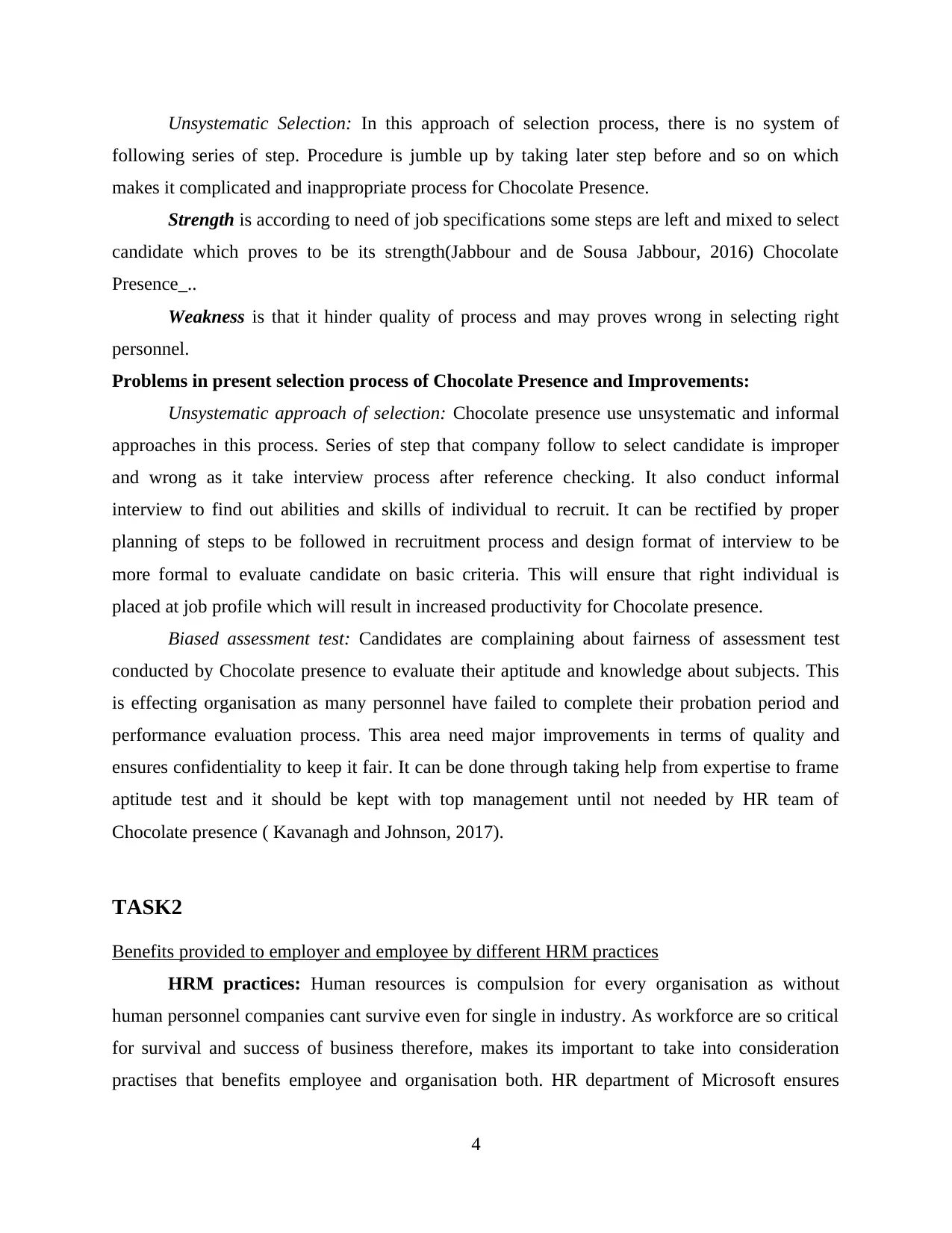
Unsystematic Selection: In this approach of selection process, there is no system of
following series of step. Procedure is jumble up by taking later step before and so on which
makes it complicated and inappropriate process for Chocolate Presence.
Strength is according to need of job specifications some steps are left and mixed to select
candidate which proves to be its strength(Jabbour and de Sousa Jabbour, 2016) Chocolate
Presence_..
Weakness is that it hinder quality of process and may proves wrong in selecting right
personnel.
Problems in present selection process of Chocolate Presence and Improvements:
Unsystematic approach of selection: Chocolate presence use unsystematic and informal
approaches in this process. Series of step that company follow to select candidate is improper
and wrong as it take interview process after reference checking. It also conduct informal
interview to find out abilities and skills of individual to recruit. It can be rectified by proper
planning of steps to be followed in recruitment process and design format of interview to be
more formal to evaluate candidate on basic criteria. This will ensure that right individual is
placed at job profile which will result in increased productivity for Chocolate presence.
Biased assessment test: Candidates are complaining about fairness of assessment test
conducted by Chocolate presence to evaluate their aptitude and knowledge about subjects. This
is effecting organisation as many personnel have failed to complete their probation period and
performance evaluation process. This area need major improvements in terms of quality and
ensures confidentiality to keep it fair. It can be done through taking help from expertise to frame
aptitude test and it should be kept with top management until not needed by HR team of
Chocolate presence ( Kavanagh and Johnson, 2017).
TASK2
Benefits provided to employer and employee by different HRM practices
HRM practices: Human resources is compulsion for every organisation as without
human personnel companies cant survive even for single in industry. As workforce are so critical
for survival and success of business therefore, makes its important to take into consideration
practises that benefits employee and organisation both. HR department of Microsoft ensures
4
following series of step. Procedure is jumble up by taking later step before and so on which
makes it complicated and inappropriate process for Chocolate Presence.
Strength is according to need of job specifications some steps are left and mixed to select
candidate which proves to be its strength(Jabbour and de Sousa Jabbour, 2016) Chocolate
Presence_..
Weakness is that it hinder quality of process and may proves wrong in selecting right
personnel.
Problems in present selection process of Chocolate Presence and Improvements:
Unsystematic approach of selection: Chocolate presence use unsystematic and informal
approaches in this process. Series of step that company follow to select candidate is improper
and wrong as it take interview process after reference checking. It also conduct informal
interview to find out abilities and skills of individual to recruit. It can be rectified by proper
planning of steps to be followed in recruitment process and design format of interview to be
more formal to evaluate candidate on basic criteria. This will ensure that right individual is
placed at job profile which will result in increased productivity for Chocolate presence.
Biased assessment test: Candidates are complaining about fairness of assessment test
conducted by Chocolate presence to evaluate their aptitude and knowledge about subjects. This
is effecting organisation as many personnel have failed to complete their probation period and
performance evaluation process. This area need major improvements in terms of quality and
ensures confidentiality to keep it fair. It can be done through taking help from expertise to frame
aptitude test and it should be kept with top management until not needed by HR team of
Chocolate presence ( Kavanagh and Johnson, 2017).
TASK2
Benefits provided to employer and employee by different HRM practices
HRM practices: Human resources is compulsion for every organisation as without
human personnel companies cant survive even for single in industry. As workforce are so critical
for survival and success of business therefore, makes its important to take into consideration
practises that benefits employee and organisation both. HR department of Microsoft ensures
4
⊘ This is a preview!⊘
Do you want full access?
Subscribe today to unlock all pages.

Trusted by 1+ million students worldwide
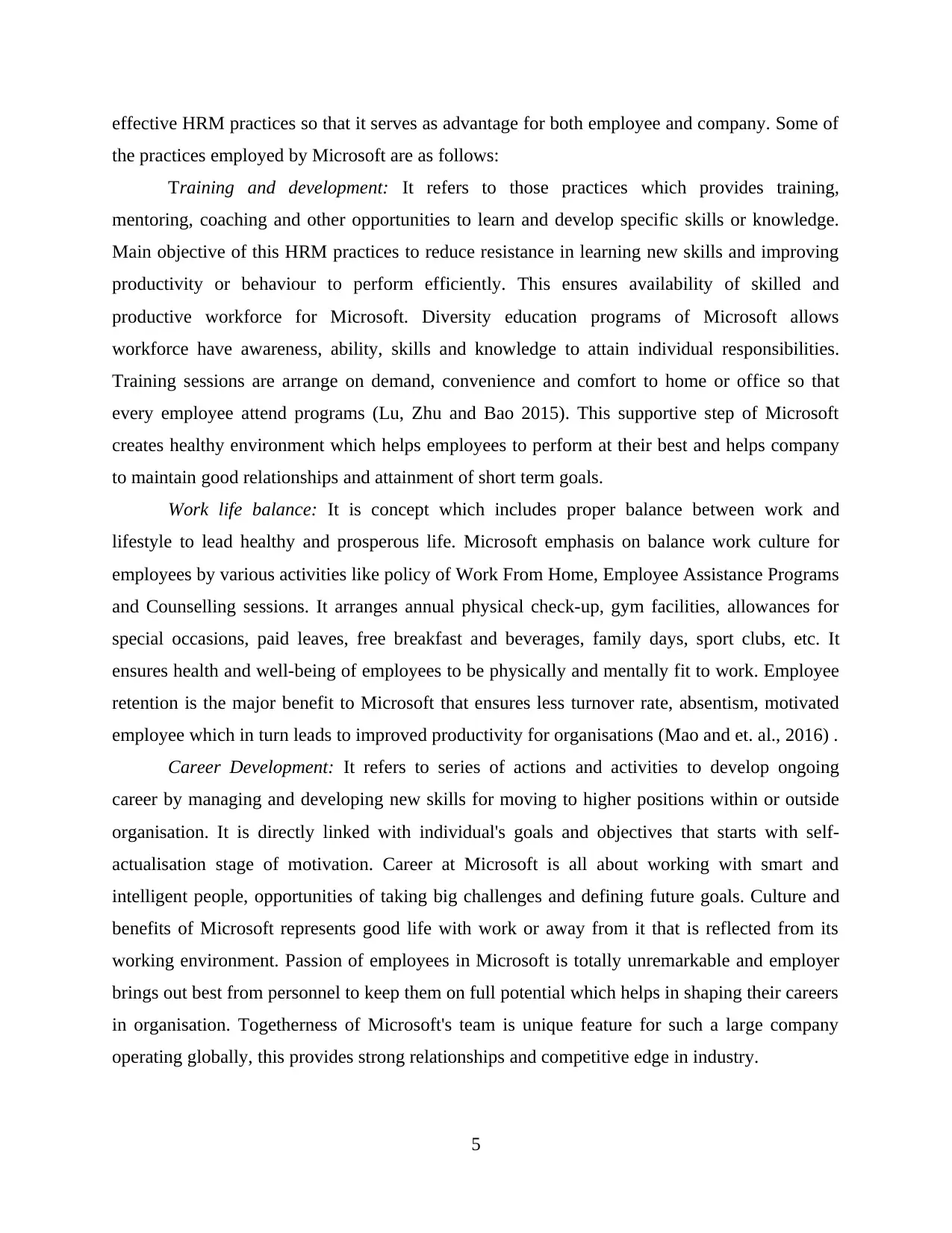
effective HRM practices so that it serves as advantage for both employee and company. Some of
the practices employed by Microsoft are as follows:
Training and development: It refers to those practices which provides training,
mentoring, coaching and other opportunities to learn and develop specific skills or knowledge.
Main objective of this HRM practices to reduce resistance in learning new skills and improving
productivity or behaviour to perform efficiently. This ensures availability of skilled and
productive workforce for Microsoft. Diversity education programs of Microsoft allows
workforce have awareness, ability, skills and knowledge to attain individual responsibilities.
Training sessions are arrange on demand, convenience and comfort to home or office so that
every employee attend programs (Lu, Zhu and Bao 2015). This supportive step of Microsoft
creates healthy environment which helps employees to perform at their best and helps company
to maintain good relationships and attainment of short term goals.
Work life balance: It is concept which includes proper balance between work and
lifestyle to lead healthy and prosperous life. Microsoft emphasis on balance work culture for
employees by various activities like policy of Work From Home, Employee Assistance Programs
and Counselling sessions. It arranges annual physical check-up, gym facilities, allowances for
special occasions, paid leaves, free breakfast and beverages, family days, sport clubs, etc. It
ensures health and well-being of employees to be physically and mentally fit to work. Employee
retention is the major benefit to Microsoft that ensures less turnover rate, absentism, motivated
employee which in turn leads to improved productivity for organisations (Mao and et. al., 2016) .
Career Development: It refers to series of actions and activities to develop ongoing
career by managing and developing new skills for moving to higher positions within or outside
organisation. It is directly linked with individual's goals and objectives that starts with self-
actualisation stage of motivation. Career at Microsoft is all about working with smart and
intelligent people, opportunities of taking big challenges and defining future goals. Culture and
benefits of Microsoft represents good life with work or away from it that is reflected from its
working environment. Passion of employees in Microsoft is totally unremarkable and employer
brings out best from personnel to keep them on full potential which helps in shaping their careers
in organisation. Togetherness of Microsoft's team is unique feature for such a large company
operating globally, this provides strong relationships and competitive edge in industry.
5
the practices employed by Microsoft are as follows:
Training and development: It refers to those practices which provides training,
mentoring, coaching and other opportunities to learn and develop specific skills or knowledge.
Main objective of this HRM practices to reduce resistance in learning new skills and improving
productivity or behaviour to perform efficiently. This ensures availability of skilled and
productive workforce for Microsoft. Diversity education programs of Microsoft allows
workforce have awareness, ability, skills and knowledge to attain individual responsibilities.
Training sessions are arrange on demand, convenience and comfort to home or office so that
every employee attend programs (Lu, Zhu and Bao 2015). This supportive step of Microsoft
creates healthy environment which helps employees to perform at their best and helps company
to maintain good relationships and attainment of short term goals.
Work life balance: It is concept which includes proper balance between work and
lifestyle to lead healthy and prosperous life. Microsoft emphasis on balance work culture for
employees by various activities like policy of Work From Home, Employee Assistance Programs
and Counselling sessions. It arranges annual physical check-up, gym facilities, allowances for
special occasions, paid leaves, free breakfast and beverages, family days, sport clubs, etc. It
ensures health and well-being of employees to be physically and mentally fit to work. Employee
retention is the major benefit to Microsoft that ensures less turnover rate, absentism, motivated
employee which in turn leads to improved productivity for organisations (Mao and et. al., 2016) .
Career Development: It refers to series of actions and activities to develop ongoing
career by managing and developing new skills for moving to higher positions within or outside
organisation. It is directly linked with individual's goals and objectives that starts with self-
actualisation stage of motivation. Career at Microsoft is all about working with smart and
intelligent people, opportunities of taking big challenges and defining future goals. Culture and
benefits of Microsoft represents good life with work or away from it that is reflected from its
working environment. Passion of employees in Microsoft is totally unremarkable and employer
brings out best from personnel to keep them on full potential which helps in shaping their careers
in organisation. Togetherness of Microsoft's team is unique feature for such a large company
operating globally, this provides strong relationships and competitive edge in industry.
5
Paraphrase This Document
Need a fresh take? Get an instant paraphrase of this document with our AI Paraphraser
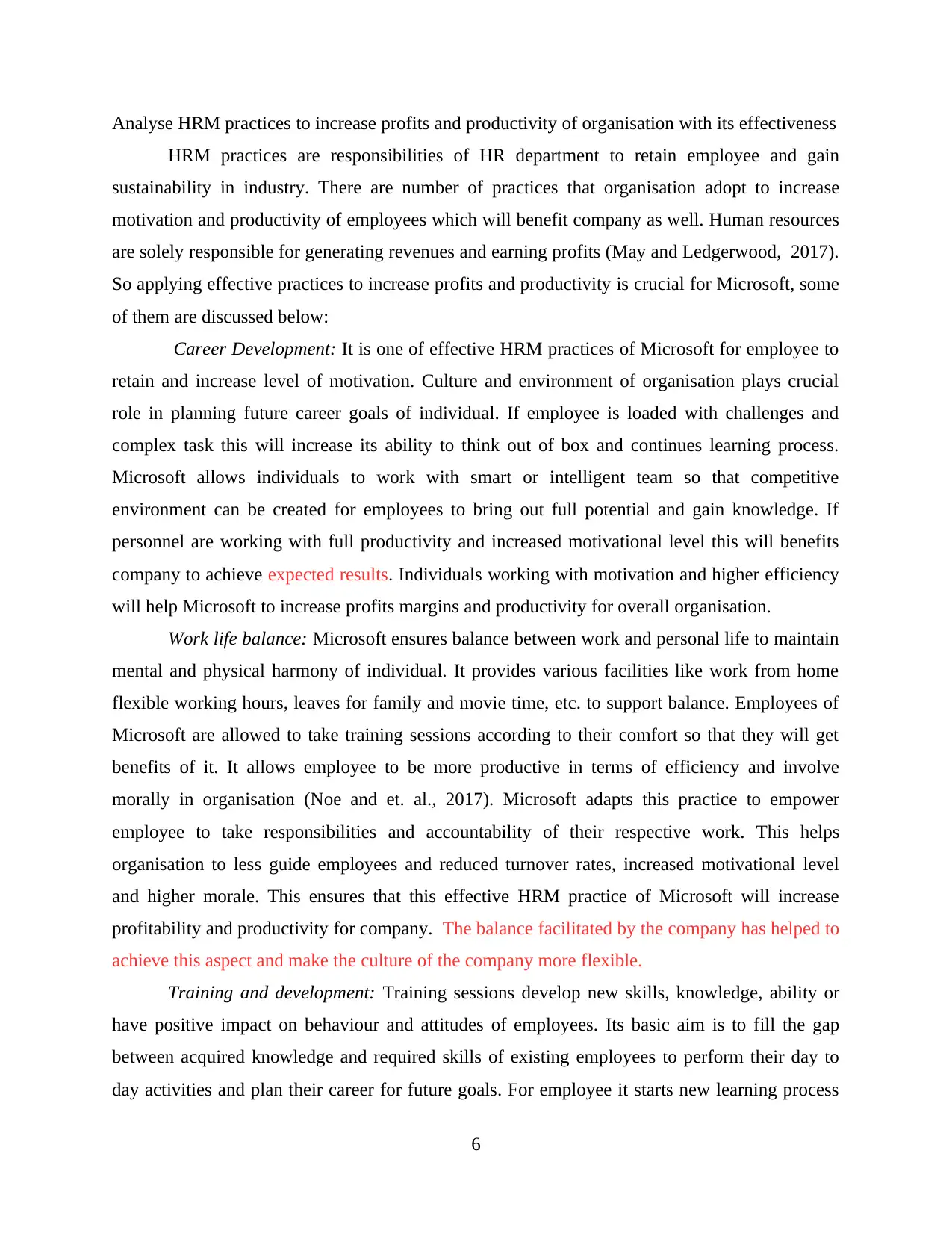
Analyse HRM practices to increase profits and productivity of organisation with its effectiveness
HRM practices are responsibilities of HR department to retain employee and gain
sustainability in industry. There are number of practices that organisation adopt to increase
motivation and productivity of employees which will benefit company as well. Human resources
are solely responsible for generating revenues and earning profits (May and Ledgerwood, 2017).
So applying effective practices to increase profits and productivity is crucial for Microsoft, some
of them are discussed below:
Career Development: It is one of effective HRM practices of Microsoft for employee to
retain and increase level of motivation. Culture and environment of organisation plays crucial
role in planning future career goals of individual. If employee is loaded with challenges and
complex task this will increase its ability to think out of box and continues learning process.
Microsoft allows individuals to work with smart or intelligent team so that competitive
environment can be created for employees to bring out full potential and gain knowledge. If
personnel are working with full productivity and increased motivational level this will benefits
company to achieve expected results. Individuals working with motivation and higher efficiency
will help Microsoft to increase profits margins and productivity for overall organisation.
Work life balance: Microsoft ensures balance between work and personal life to maintain
mental and physical harmony of individual. It provides various facilities like work from home
flexible working hours, leaves for family and movie time, etc. to support balance. Employees of
Microsoft are allowed to take training sessions according to their comfort so that they will get
benefits of it. It allows employee to be more productive in terms of efficiency and involve
morally in organisation (Noe and et. al., 2017). Microsoft adapts this practice to empower
employee to take responsibilities and accountability of their respective work. This helps
organisation to less guide employees and reduced turnover rates, increased motivational level
and higher morale. This ensures that this effective HRM practice of Microsoft will increase
profitability and productivity for company. The balance facilitated by the company has helped to
achieve this aspect and make the culture of the company more flexible.
Training and development: Training sessions develop new skills, knowledge, ability or
have positive impact on behaviour and attitudes of employees. Its basic aim is to fill the gap
between acquired knowledge and required skills of existing employees to perform their day to
day activities and plan their career for future goals. For employee it starts new learning process
6
HRM practices are responsibilities of HR department to retain employee and gain
sustainability in industry. There are number of practices that organisation adopt to increase
motivation and productivity of employees which will benefit company as well. Human resources
are solely responsible for generating revenues and earning profits (May and Ledgerwood, 2017).
So applying effective practices to increase profits and productivity is crucial for Microsoft, some
of them are discussed below:
Career Development: It is one of effective HRM practices of Microsoft for employee to
retain and increase level of motivation. Culture and environment of organisation plays crucial
role in planning future career goals of individual. If employee is loaded with challenges and
complex task this will increase its ability to think out of box and continues learning process.
Microsoft allows individuals to work with smart or intelligent team so that competitive
environment can be created for employees to bring out full potential and gain knowledge. If
personnel are working with full productivity and increased motivational level this will benefits
company to achieve expected results. Individuals working with motivation and higher efficiency
will help Microsoft to increase profits margins and productivity for overall organisation.
Work life balance: Microsoft ensures balance between work and personal life to maintain
mental and physical harmony of individual. It provides various facilities like work from home
flexible working hours, leaves for family and movie time, etc. to support balance. Employees of
Microsoft are allowed to take training sessions according to their comfort so that they will get
benefits of it. It allows employee to be more productive in terms of efficiency and involve
morally in organisation (Noe and et. al., 2017). Microsoft adapts this practice to empower
employee to take responsibilities and accountability of their respective work. This helps
organisation to less guide employees and reduced turnover rates, increased motivational level
and higher morale. This ensures that this effective HRM practice of Microsoft will increase
profitability and productivity for company. The balance facilitated by the company has helped to
achieve this aspect and make the culture of the company more flexible.
Training and development: Training sessions develop new skills, knowledge, ability or
have positive impact on behaviour and attitudes of employees. Its basic aim is to fill the gap
between acquired knowledge and required skills of existing employees to perform their day to
day activities and plan their career for future goals. For employee it starts new learning process
6
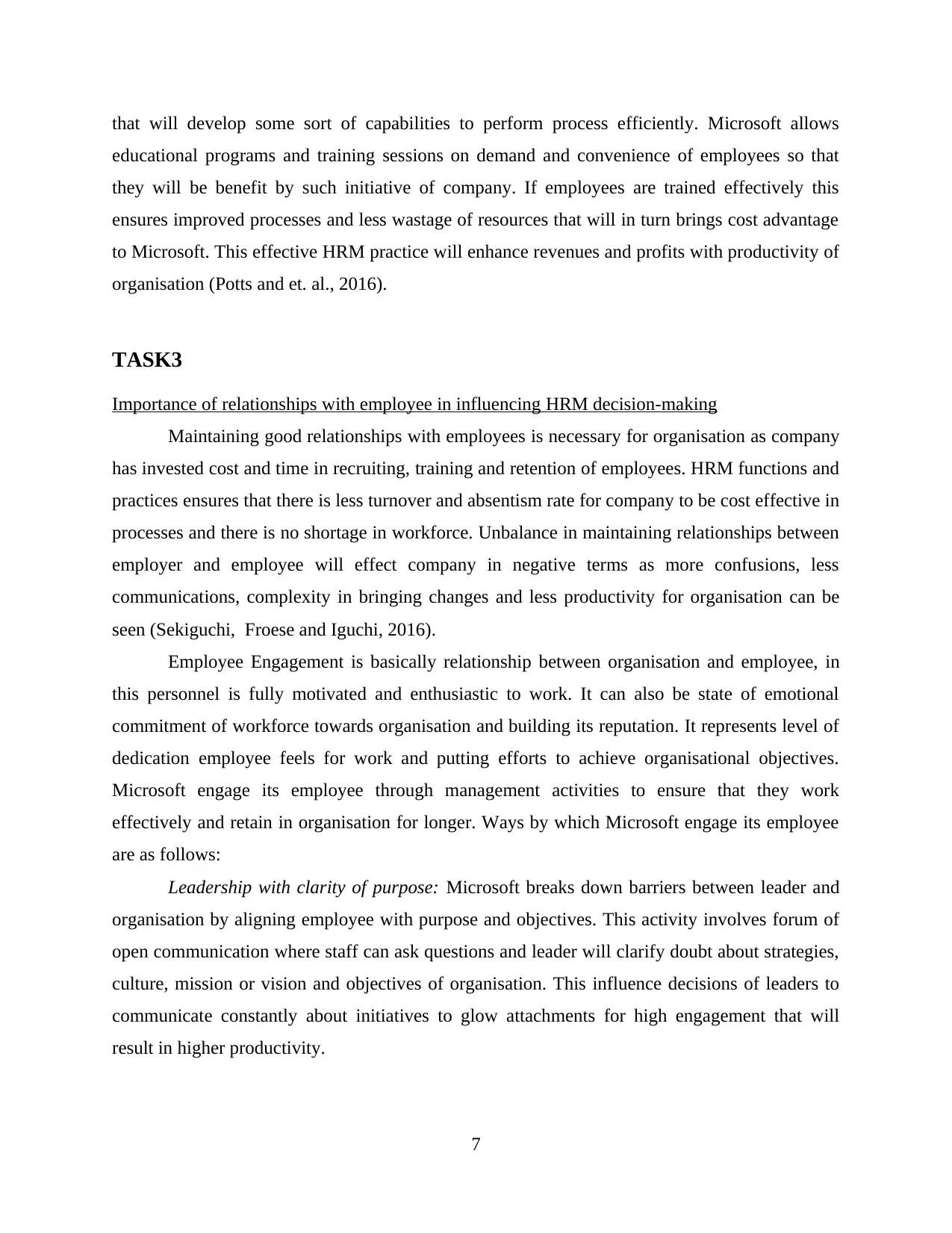
that will develop some sort of capabilities to perform process efficiently. Microsoft allows
educational programs and training sessions on demand and convenience of employees so that
they will be benefit by such initiative of company. If employees are trained effectively this
ensures improved processes and less wastage of resources that will in turn brings cost advantage
to Microsoft. This effective HRM practice will enhance revenues and profits with productivity of
organisation (Potts and et. al., 2016).
TASK3
Importance of relationships with employee in influencing HRM decision-making
Maintaining good relationships with employees is necessary for organisation as company
has invested cost and time in recruiting, training and retention of employees. HRM functions and
practices ensures that there is less turnover and absentism rate for company to be cost effective in
processes and there is no shortage in workforce. Unbalance in maintaining relationships between
employer and employee will effect company in negative terms as more confusions, less
communications, complexity in bringing changes and less productivity for organisation can be
seen (Sekiguchi, Froese and Iguchi, 2016).
Employee Engagement is basically relationship between organisation and employee, in
this personnel is fully motivated and enthusiastic to work. It can also be state of emotional
commitment of workforce towards organisation and building its reputation. It represents level of
dedication employee feels for work and putting efforts to achieve organisational objectives.
Microsoft engage its employee through management activities to ensure that they work
effectively and retain in organisation for longer. Ways by which Microsoft engage its employee
are as follows:
Leadership with clarity of purpose: Microsoft breaks down barriers between leader and
organisation by aligning employee with purpose and objectives. This activity involves forum of
open communication where staff can ask questions and leader will clarify doubt about strategies,
culture, mission or vision and objectives of organisation. This influence decisions of leaders to
communicate constantly about initiatives to glow attachments for high engagement that will
result in higher productivity.
7
educational programs and training sessions on demand and convenience of employees so that
they will be benefit by such initiative of company. If employees are trained effectively this
ensures improved processes and less wastage of resources that will in turn brings cost advantage
to Microsoft. This effective HRM practice will enhance revenues and profits with productivity of
organisation (Potts and et. al., 2016).
TASK3
Importance of relationships with employee in influencing HRM decision-making
Maintaining good relationships with employees is necessary for organisation as company
has invested cost and time in recruiting, training and retention of employees. HRM functions and
practices ensures that there is less turnover and absentism rate for company to be cost effective in
processes and there is no shortage in workforce. Unbalance in maintaining relationships between
employer and employee will effect company in negative terms as more confusions, less
communications, complexity in bringing changes and less productivity for organisation can be
seen (Sekiguchi, Froese and Iguchi, 2016).
Employee Engagement is basically relationship between organisation and employee, in
this personnel is fully motivated and enthusiastic to work. It can also be state of emotional
commitment of workforce towards organisation and building its reputation. It represents level of
dedication employee feels for work and putting efforts to achieve organisational objectives.
Microsoft engage its employee through management activities to ensure that they work
effectively and retain in organisation for longer. Ways by which Microsoft engage its employee
are as follows:
Leadership with clarity of purpose: Microsoft breaks down barriers between leader and
organisation by aligning employee with purpose and objectives. This activity involves forum of
open communication where staff can ask questions and leader will clarify doubt about strategies,
culture, mission or vision and objectives of organisation. This influence decisions of leaders to
communicate constantly about initiatives to glow attachments for high engagement that will
result in higher productivity.
7
⊘ This is a preview!⊘
Do you want full access?
Subscribe today to unlock all pages.

Trusted by 1+ million students worldwide
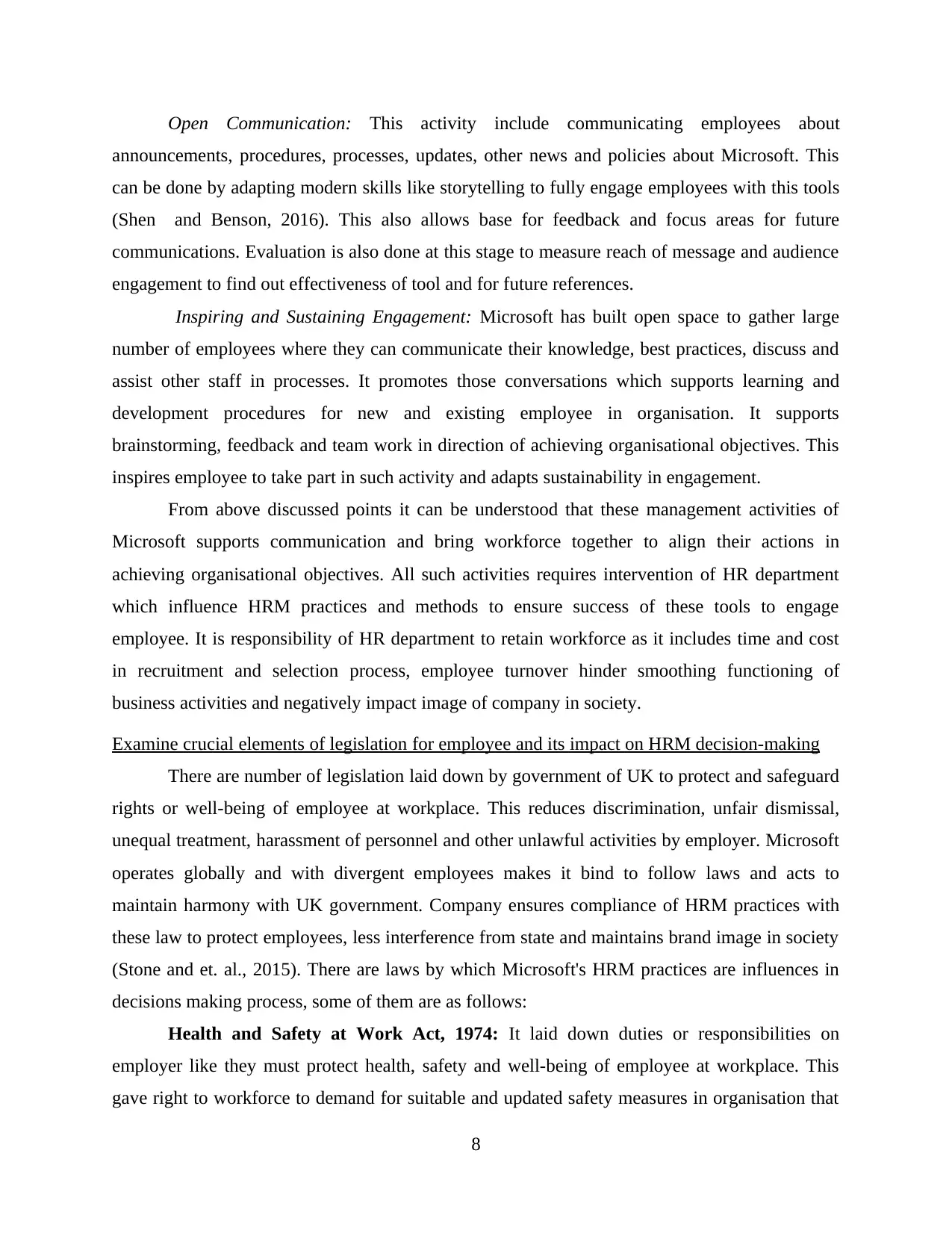
Open Communication: This activity include communicating employees about
announcements, procedures, processes, updates, other news and policies about Microsoft. This
can be done by adapting modern skills like storytelling to fully engage employees with this tools
(Shen and Benson, 2016). This also allows base for feedback and focus areas for future
communications. Evaluation is also done at this stage to measure reach of message and audience
engagement to find out effectiveness of tool and for future references.
Inspiring and Sustaining Engagement: Microsoft has built open space to gather large
number of employees where they can communicate their knowledge, best practices, discuss and
assist other staff in processes. It promotes those conversations which supports learning and
development procedures for new and existing employee in organisation. It supports
brainstorming, feedback and team work in direction of achieving organisational objectives. This
inspires employee to take part in such activity and adapts sustainability in engagement.
From above discussed points it can be understood that these management activities of
Microsoft supports communication and bring workforce together to align their actions in
achieving organisational objectives. All such activities requires intervention of HR department
which influence HRM practices and methods to ensure success of these tools to engage
employee. It is responsibility of HR department to retain workforce as it includes time and cost
in recruitment and selection process, employee turnover hinder smoothing functioning of
business activities and negatively impact image of company in society.
Examine crucial elements of legislation for employee and its impact on HRM decision-making
There are number of legislation laid down by government of UK to protect and safeguard
rights or well-being of employee at workplace. This reduces discrimination, unfair dismissal,
unequal treatment, harassment of personnel and other unlawful activities by employer. Microsoft
operates globally and with divergent employees makes it bind to follow laws and acts to
maintain harmony with UK government. Company ensures compliance of HRM practices with
these law to protect employees, less interference from state and maintains brand image in society
(Stone and et. al., 2015). There are laws by which Microsoft's HRM practices are influences in
decisions making process, some of them are as follows:
Health and Safety at Work Act, 1974: It laid down duties or responsibilities on
employer like they must protect health, safety and well-being of employee at workplace. This
gave right to workforce to demand for suitable and updated safety measures in organisation that
8
announcements, procedures, processes, updates, other news and policies about Microsoft. This
can be done by adapting modern skills like storytelling to fully engage employees with this tools
(Shen and Benson, 2016). This also allows base for feedback and focus areas for future
communications. Evaluation is also done at this stage to measure reach of message and audience
engagement to find out effectiveness of tool and for future references.
Inspiring and Sustaining Engagement: Microsoft has built open space to gather large
number of employees where they can communicate their knowledge, best practices, discuss and
assist other staff in processes. It promotes those conversations which supports learning and
development procedures for new and existing employee in organisation. It supports
brainstorming, feedback and team work in direction of achieving organisational objectives. This
inspires employee to take part in such activity and adapts sustainability in engagement.
From above discussed points it can be understood that these management activities of
Microsoft supports communication and bring workforce together to align their actions in
achieving organisational objectives. All such activities requires intervention of HR department
which influence HRM practices and methods to ensure success of these tools to engage
employee. It is responsibility of HR department to retain workforce as it includes time and cost
in recruitment and selection process, employee turnover hinder smoothing functioning of
business activities and negatively impact image of company in society.
Examine crucial elements of legislation for employee and its impact on HRM decision-making
There are number of legislation laid down by government of UK to protect and safeguard
rights or well-being of employee at workplace. This reduces discrimination, unfair dismissal,
unequal treatment, harassment of personnel and other unlawful activities by employer. Microsoft
operates globally and with divergent employees makes it bind to follow laws and acts to
maintain harmony with UK government. Company ensures compliance of HRM practices with
these law to protect employees, less interference from state and maintains brand image in society
(Stone and et. al., 2015). There are laws by which Microsoft's HRM practices are influences in
decisions making process, some of them are as follows:
Health and Safety at Work Act, 1974: It laid down duties or responsibilities on
employer like they must protect health, safety and well-being of employee at workplace. This
gave right to workforce to demand for suitable and updated safety measures in organisation that
8
Paraphrase This Document
Need a fresh take? Get an instant paraphrase of this document with our AI Paraphraser
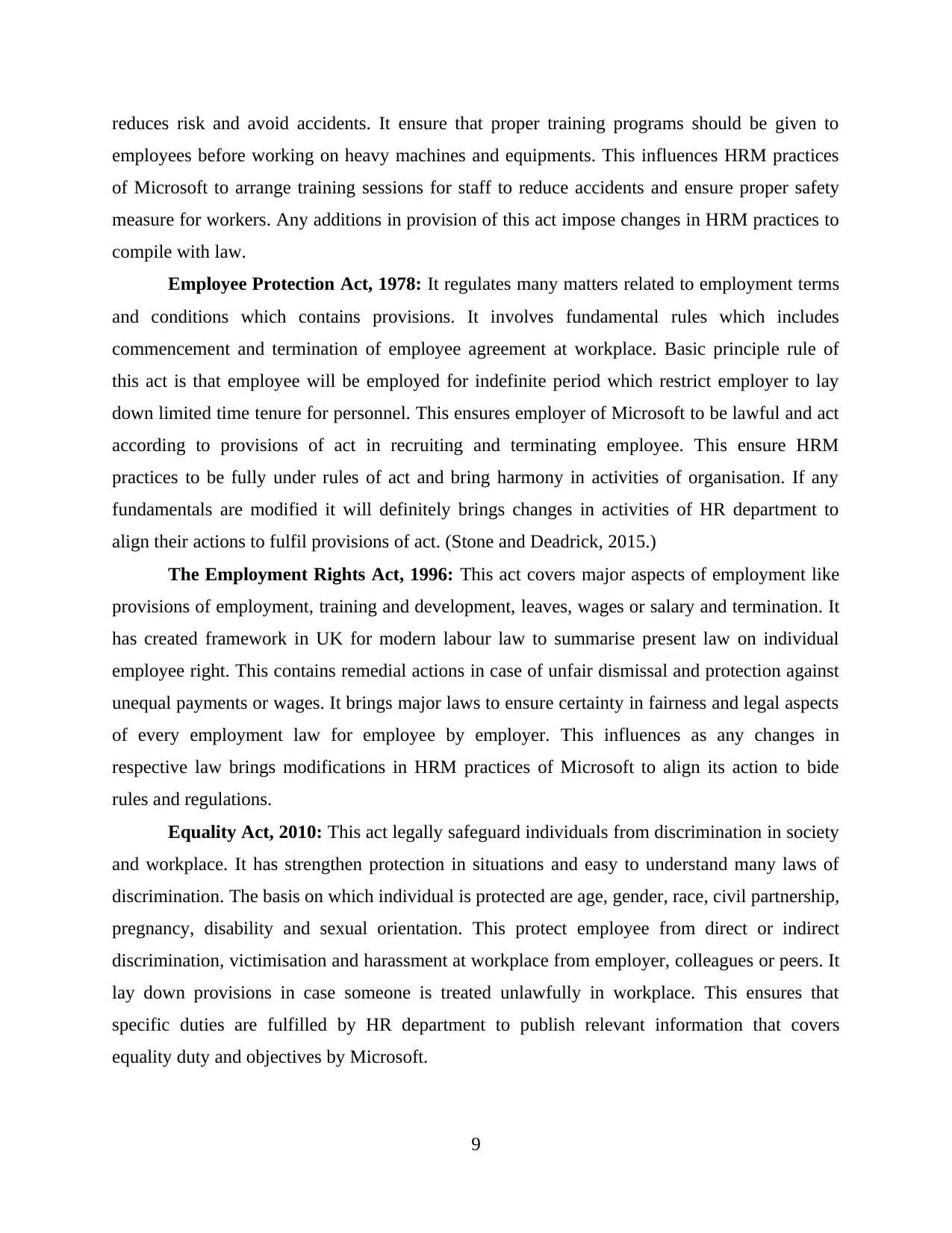
reduces risk and avoid accidents. It ensure that proper training programs should be given to
employees before working on heavy machines and equipments. This influences HRM practices
of Microsoft to arrange training sessions for staff to reduce accidents and ensure proper safety
measure for workers. Any additions in provision of this act impose changes in HRM practices to
compile with law.
Employee Protection Act, 1978: It regulates many matters related to employment terms
and conditions which contains provisions. It involves fundamental rules which includes
commencement and termination of employee agreement at workplace. Basic principle rule of
this act is that employee will be employed for indefinite period which restrict employer to lay
down limited time tenure for personnel. This ensures employer of Microsoft to be lawful and act
according to provisions of act in recruiting and terminating employee. This ensure HRM
practices to be fully under rules of act and bring harmony in activities of organisation. If any
fundamentals are modified it will definitely brings changes in activities of HR department to
align their actions to fulfil provisions of act. (Stone and Deadrick, 2015.)
The Employment Rights Act, 1996: This act covers major aspects of employment like
provisions of employment, training and development, leaves, wages or salary and termination. It
has created framework in UK for modern labour law to summarise present law on individual
employee right. This contains remedial actions in case of unfair dismissal and protection against
unequal payments or wages. It brings major laws to ensure certainty in fairness and legal aspects
of every employment law for employee by employer. This influences as any changes in
respective law brings modifications in HRM practices of Microsoft to align its action to bide
rules and regulations.
Equality Act, 2010: This act legally safeguard individuals from discrimination in society
and workplace. It has strengthen protection in situations and easy to understand many laws of
discrimination. The basis on which individual is protected are age, gender, race, civil partnership,
pregnancy, disability and sexual orientation. This protect employee from direct or indirect
discrimination, victimisation and harassment at workplace from employer, colleagues or peers. It
lay down provisions in case someone is treated unlawfully in workplace. This ensures that
specific duties are fulfilled by HR department to publish relevant information that covers
equality duty and objectives by Microsoft.
9
employees before working on heavy machines and equipments. This influences HRM practices
of Microsoft to arrange training sessions for staff to reduce accidents and ensure proper safety
measure for workers. Any additions in provision of this act impose changes in HRM practices to
compile with law.
Employee Protection Act, 1978: It regulates many matters related to employment terms
and conditions which contains provisions. It involves fundamental rules which includes
commencement and termination of employee agreement at workplace. Basic principle rule of
this act is that employee will be employed for indefinite period which restrict employer to lay
down limited time tenure for personnel. This ensures employer of Microsoft to be lawful and act
according to provisions of act in recruiting and terminating employee. This ensure HRM
practices to be fully under rules of act and bring harmony in activities of organisation. If any
fundamentals are modified it will definitely brings changes in activities of HR department to
align their actions to fulfil provisions of act. (Stone and Deadrick, 2015.)
The Employment Rights Act, 1996: This act covers major aspects of employment like
provisions of employment, training and development, leaves, wages or salary and termination. It
has created framework in UK for modern labour law to summarise present law on individual
employee right. This contains remedial actions in case of unfair dismissal and protection against
unequal payments or wages. It brings major laws to ensure certainty in fairness and legal aspects
of every employment law for employee by employer. This influences as any changes in
respective law brings modifications in HRM practices of Microsoft to align its action to bide
rules and regulations.
Equality Act, 2010: This act legally safeguard individuals from discrimination in society
and workplace. It has strengthen protection in situations and easy to understand many laws of
discrimination. The basis on which individual is protected are age, gender, race, civil partnership,
pregnancy, disability and sexual orientation. This protect employee from direct or indirect
discrimination, victimisation and harassment at workplace from employer, colleagues or peers. It
lay down provisions in case someone is treated unlawfully in workplace. This ensures that
specific duties are fulfilled by HR department to publish relevant information that covers
equality duty and objectives by Microsoft.
9
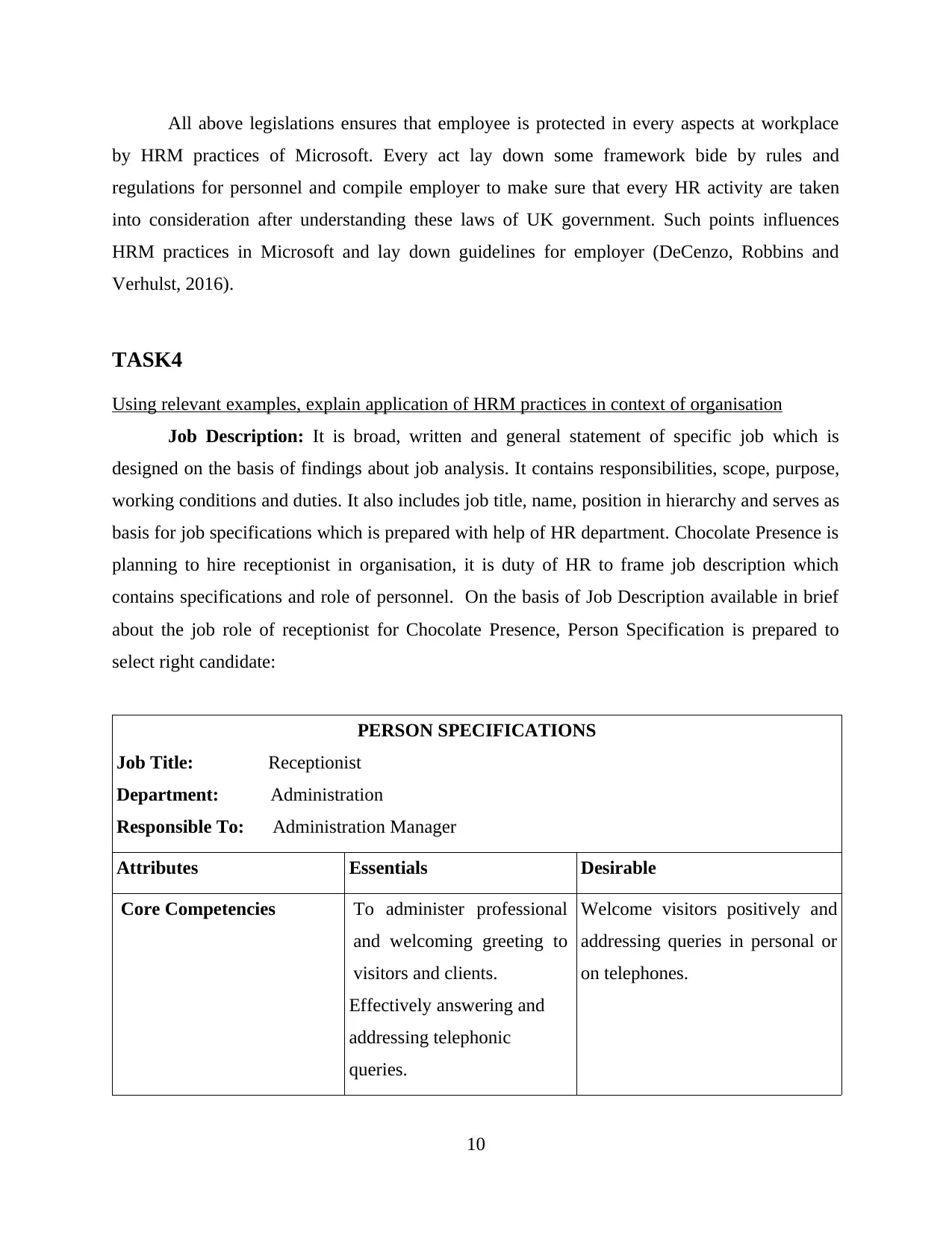
All above legislations ensures that employee is protected in every aspects at workplace
by HRM practices of Microsoft. Every act lay down some framework bide by rules and
regulations for personnel and compile employer to make sure that every HR activity are taken
into consideration after understanding these laws of UK government. Such points influences
HRM practices in Microsoft and lay down guidelines for employer (DeCenzo, Robbins and
Verhulst, 2016).
TASK4
Using relevant examples, explain application of HRM practices in context of organisation
Job Description: It is broad, written and general statement of specific job which is
designed on the basis of findings about job analysis. It contains responsibilities, scope, purpose,
working conditions and duties. It also includes job title, name, position in hierarchy and serves as
basis for job specifications which is prepared with help of HR department. Chocolate Presence is
planning to hire receptionist in organisation, it is duty of HR to frame job description which
contains specifications and role of personnel. On the basis of Job Description available in brief
about the job role of receptionist for Chocolate Presence, Person Specification is prepared to
select right candidate:
PERSON SPECIFICATIONS
Job Title: Receptionist
Department: Administration
Responsible To: Administration Manager
Attributes Essentials Desirable
Core Competencies To administer professional
and welcoming greeting to
visitors and clients.
Effectively answering and
addressing telephonic
queries.
Welcome visitors positively and
addressing queries in personal or
on telephones.
10
by HRM practices of Microsoft. Every act lay down some framework bide by rules and
regulations for personnel and compile employer to make sure that every HR activity are taken
into consideration after understanding these laws of UK government. Such points influences
HRM practices in Microsoft and lay down guidelines for employer (DeCenzo, Robbins and
Verhulst, 2016).
TASK4
Using relevant examples, explain application of HRM practices in context of organisation
Job Description: It is broad, written and general statement of specific job which is
designed on the basis of findings about job analysis. It contains responsibilities, scope, purpose,
working conditions and duties. It also includes job title, name, position in hierarchy and serves as
basis for job specifications which is prepared with help of HR department. Chocolate Presence is
planning to hire receptionist in organisation, it is duty of HR to frame job description which
contains specifications and role of personnel. On the basis of Job Description available in brief
about the job role of receptionist for Chocolate Presence, Person Specification is prepared to
select right candidate:
PERSON SPECIFICATIONS
Job Title: Receptionist
Department: Administration
Responsible To: Administration Manager
Attributes Essentials Desirable
Core Competencies To administer professional
and welcoming greeting to
visitors and clients.
Effectively answering and
addressing telephonic
queries.
Welcome visitors positively and
addressing queries in personal or
on telephones.
10
⊘ This is a preview!⊘
Do you want full access?
Subscribe today to unlock all pages.

Trusted by 1+ million students worldwide
1 out of 17
Related Documents
Your All-in-One AI-Powered Toolkit for Academic Success.
+13062052269
info@desklib.com
Available 24*7 on WhatsApp / Email
![[object Object]](/_next/static/media/star-bottom.7253800d.svg)
Unlock your academic potential
Copyright © 2020–2025 A2Z Services. All Rights Reserved. Developed and managed by ZUCOL.





